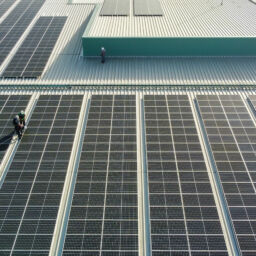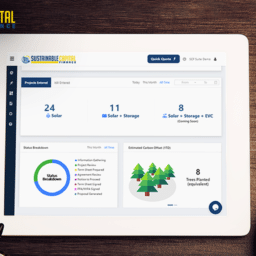Following the confirmation of President Trump in 2017, concern mounted regarding tax reform and the potential impact on the solar industry. One of the main benefits of third party ownership of solar assets is the tax liability savings, consisting of the investment tax credit (ITC) and the Bonus MACRS Depreciation. If these are reduced or eliminated, it would obviously have a significant negative impact on solar ownership.
Most of the solar industry agrees that the administration is unlikely to touch the Omnibus Bill that allowed for the continuance of the Investment Tax Credit. That being said, if the federal tax rate decreases from 35% to the proposed 15%, the ability to receive the full amount of the ITC in the first year (any unused amount can be carry-forward to the next year) and not receive the full benefit of bonus depreciation will be negatively impacted. The federal tax rate isn’t the only concern for the solar industry.
The following tax code adjustments could impact the financing and third party ownership of solar projects:
- Reduction in the corporate income tax rate
- Changes or Elimination of the Investment Tax Credit (ITC)
- Changes or elimination of the Accelerated and Bonus Depreciation (MACRS)
- Implementation of the Border Adjustment Tax (BAT)
The corporate tax rate is currently set at 35%, but proposed tax cuts could lower it to as much as 15%. If this were to occur it could have a negative impact on the tax equity available in the market, as banks, utilities, and insurance companies would not be able to monetize 100% of the ITC in the first year. Less tax equity in the market would create an adverse condition in solar financing.
As mentioned, in December of 2015 Congress also revised and extended the investment tax credit (“ITC”) under Section 48 of the Internal Revenue Code for solar projects. The value of the ITC for solar energy property is equal to 30% of the cost of the investment if construction begins in 2017, 2018, or 2019. The value decreases to 26 percent of the cost of the investment if construction begins in 2020, and to 22 percent if construction begins in 2021. The value of the credit is then reduced to 10 percent of the cost of the investment in perpetuity for commercial and utility installations (residential installations will be set at zero). In January of 2016, after the ITC extension, it was estimated that approximately $10 billion in tax equity would be needed to fuel solar growth over the next five to seven years. However, any tax rate reductions could reduce tax liability offsets potential investors may have, which would have a negative impact on solar financing.
Beyond the tax credits, there are qualifying depreciable renewable energy property benefits from accelerated depreciation and bonus depreciation. Under Section 168 of the Internal Revenue Code, most solar property is classified as “5-year property” for purposes of accelerated depreciation. In addition, under Section 168(k) of the Code, 5-year property also qualifies for bonus depreciation, allowing taxpayers to deduct 50 percent of the cost of the qualified property in the first year it is placed in service and the remainder is deducted over the remaining depreciable life of the property. Bonus depreciation was previously scheduled to expire, but Congress extended bonus depreciation in 2015, subject to a phasedown. The percentage that can be expensed in the first year remains at 50 percent for qualified energy property that is placed in service before 2018. It is reduced to 40 percent for property placed in service in 2018 and further reduced to 30 percent for property placed in service in 2019. After 2019, bonus depreciation is scheduled to expire. At this time, it is not clear if the Trump administrations tax plan will impact the treatment of depreciation. If this is eliminated, it could have a dramatic effect on solar installations and solar financing.
Below is an example of a company investing $600,000 in a solar project, and generating revenue of $50,000 and incurring expenses of $45,000 in the first year. In addition, the company has other revenue and expenses of $950,000 and $0, respectively. The analysis is referring to only the first year of the project, but please note that this project could have a useful life of up to twenty years. The company has calculated their tax liability for a tax rate of 35% and 15%, and wants to determine tax liability offset savings. It first must decide what depreciation method to use (Bonus MACRS Depreciation or the Traditional MACRS Depreciation). Please note that there is no carry forward for depreciation. Once this is completed, it will apply any remaining tax liability to the investment tax credit (ITC). Any unused amount of the ITC can be carry-forward to future periods.
The first step is to calculate the investment tax credit amount of $180,000 ($600,000 project cost multiplied by the 30% ITC), and the depreciable asset value to be used in the MACRS depreciation of $510,000 (Project cost minus 50% of the ITC).

Next, calculate the annual MACRS depreciation. Please note that in year one the difference between the traditional MACRS depreciation and the bonus MACRS depreciation is $204,000.

Then calculate the tax liability using both a 35% and 15% tax rate, and the bonus MACRS depreciation and traditional MACRS Depreciation.

An analysis of the data reveals the following:
- If bonus MACRS depreciation is used, a tax rate reduction from 35% to 15% would result in a decrease in tax liability savings of $82,650 (or 13.8% of the investment value).
- Using the traditional MACRS, a tax rate reduction 35% to 15% would result in a decrease in tax liability savings of $52,050 (or 8.7% of the investment value).
- A reduction in the tax rate from 35% to 15% would result in a reduced tax liability savings. Selection of a depreciation method to could be based on the ITC strategy (maximum savings in year 1 or carry forward into future periods).
Border Adjustment Tax:
A border adjustment tax (BAT), is a valued added tax levied on imported goods. It is part of the proposed overhaul of the tax code suggesting a sweeping redesign of the current corporate tax framework, which it calls a destination-based cash flow tax (DBCFT). If enacted, it could raise prices of solar equipment from foreign equipment manufacturers by as much as a 20% tax on imports. This could have an adverse effect on the demand for installations, which would also negatively impact solar financing. The adoption of the border adjustment by the United States will cause both double taxation of import flows and non-taxation of export flows, which is inconsistent with the principles of international tax treaties currently in place.
The potentially high incremental tax burden generated by the border adjustment may indeed provide sufficient incentives for companies to relocate some of their foreign manufacturing operations to the United States. However, this does not guarantee that the product costs will be as low as they were prior to the border adjustment.
Because the border adjustment is essentially trade policy affected through tax policy, it is conceivable that other countries will adopt similar tax policies, tantamount to trade retaliation. If all countries adopted a border adjustment and adjusted import and export prices to zero, a company’s effective tax rate will equal the weighted average of the corporate tax rates in each country.
The effect of this on the corporate tax burden would depend on whether net importing and large domestic market countries have higher or lower tax rates than net exporting and small market countries. If net import and large domestic market countries have higher corporate tax rates than net export and small domestic market countries, corporate effective tax rates will rise. Note that the United States has the largest domestic market, is a very large net importer, and has one of the highest corporate tax rates.
A reduction in the tax rate may not have a negative impact on deciding to invest in a solar project. The decision factors may include more than just tax liability savings, such as future cash inflows and return on investment. However, until there is legislative change and a final “bill” is approved, we cannot determine the impact. Congress utilizes the legislative process to pass federal laws; this process begins when either a Senator or Representative prepares a proposed law (also called a “bill”). The “bill” is approved by congress and then sent to the President; when the President signs the “bill”, it becomes law. During this process there are multiple hearings. The average time it takes to have a “bill” passed into law is 263.57 days so some time will pass before tax changes are cemented. In the meantime, be prepared by analyzing various tax rates and their impact on project economics.








